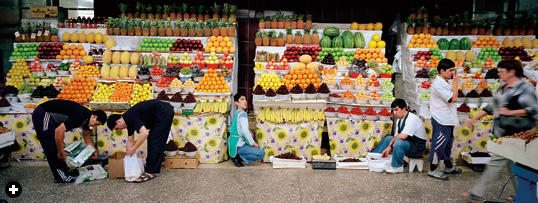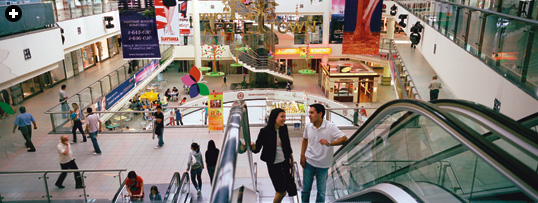
For students: We hope this two-page guide will help sharpen your reading skills and deepen your understanding of this issue’s articles.
For teachers: We encourage reproduction and adaptation of these ideas, freely and without further permission from Saudi Aramco World, by teachers at any level, whether working in a classroom or through home study.
— THE EDITORS
Class Activities
This Classroom Guide is organized around the theme of exchange. The Visual Analysis section appears at the end.
Theme: Exchange
Several articles in this edition of Saudi Aramco World address the theme of exchange. The National Economics Standards define exchange as “trading goods and services with people for other goods and services.” Another way to put it is to say that to exchange means to give and receive equally, for either objects (goods) or things people do for each other (services). But exchange can involve more than just goods and services. It can refer to other less tangible things, too, such as values, religions and ideas. Keep in mind both ways of thinking about exchange as you work on these activities. Many focus on what else gets exchanged when people go about trading goods and services.
When and what have you traded?
Let’s start close to home. Do you ever make trades? Maybe you’ve traded your sandwich for someone else’s, or traded a book you’ve read for a book you want to read. Maybe you’ve traded money for something you wanted at a store. Think about a trade you have made recently. (Remember that paying money for something is a form of exchange.) What did you give up in the trade? Why were you willing to give it up? What did you get in exchange? Why did you want it? When you think about it now, was it worth it? Summarize your trade, either in writing or with a drawing, collage or other graphic. In your summary, express your feelings about the trade. Were you satisfied? Why or why not?
What do individuals and nations trade, and why?
Individuals like you make trades. So do groups of people. Read “Where the Pepper Grows.” When you think about pepper as something to trade, ask yourself a few basic questions, and then, working with a small group, jot down answers. Where did pepper come from? Who wanted it? Why did they want it? What were they willing to exchange for it? How did the demand for pepper affect the producers? The merchants? The purchasers?
Now split the class into two groups. Have one read “A Man of Two Worlds” while the other reads “Hearts of the New Silk Roads.” Then, if you read about Leo Africanus, find the part of the article that describes the trans-Saharan trade. If you read about the Silk Roads, find the part of the article that describes the trade along the Silk Roads during their heyday. Whichever group you are in, make a map that shows the trade. On your map, show which products moved in which directions. Now imagine that the only thing you know about the people involved in either the trans-Saharan or the Silk Roads trade is what they traded to others and what they got in return. What does this information tell you about them? What conclusions can you draw? Write down some thoughts on the subject. Then do a little research in a world history textbook or on the Internet and see if you’re right.
Now that you’ve looked at the past, shift your focus to the present. In “Hearts of the New Silk Roads,” highlight the goods that writer Richard Covington sees in Almaty and Tashkent that come from other places. What do Kazakhstan and Uzbekistan offer in exchange for these products? (Notice that each country has a different primary export—the thing it sells the most of—and that what it exports affects its wealth.) Based on the imported goods Covington sees, what can you infer about what many people in Almaty and Tashkent value? What can you infer about the value of what they export?
What helps make exchange possible? What makes it harder?
Look again at “Where the Pepper Grows.” The article explains that pepper was valuable for a long time before the pepper trade really took off. With your group, identify what made it possible for the pepper trade to thrive. Certainly one set of factors was economic: There was a supply of pepper in one place and a demand for it in another. But other factors had to be in place, too. Make a web entitled “Factors that Enhanced the Pepper Trade.” In the center put “Pepper Trade.” Branching off from the center, make circles labeled “Economics,” “Politics,” “Religion” and “Culture.” Spin out the web with information from the article. Think about how the different factors came into play in the pepper exchange. Write a short summary.
Now think about the factors that made the trade harder, that inhibited it. The best examples in this edition are in “Hearts of the New Silk Roads.” What factors in Uzbekistan limit its trade? Into which category do these factors fall—politics, religion and/or culture?
What gets exchanged along with goods and services?
So far you’ve thought about what people trade, why they trade, and what encourages or discourages trade. Now step back and think a little more abstractly. This month’s articles are great examples of the fact that when people exchange things, they often exchange a lot of stuff you can’t see.
Let’s look at the pepper trade again. When Arab Muslims gained control over the pepper trade, what did they bring with them to the people along the trade routes? In other words, how did their presence change the people and the places they came into contact with? Use this prompt to begin your written answer: “When Arab Muslims controlled the pepper trade, they had a huge impact on the people of the Malabar Coast.”
How is identity affected by exchange?
Read “A Man of Two Worlds.” As you read, pay particular attention to the identity of the article’s subject, the man called Leo Africanus, who was also called Al Hassan ibn Muhammad Al-Wazzan Al Fasi. Notice from the start that he is known by more than one name! Underline the parts of the article that relate to identity. Then work on these activities.
As a young man, Leo traveled with traders. Eventually he ended up working for the Pope in Rome as a kind of an expert in—and agent of—cultural exchange. The article quotes historian Lotfi Bouchentouf saying of Leo, “He was a Muslim, living as a Christian, writing for a Christian audience, about the world of Islam.”
As a class, use what you have read in the article to discuss the quote. Here are a few guiding questions: What might it mean to be “a Muslim living as a Christian”? How might it affect someone to hold one religion’s beliefs but to practice a different religion in public? What kinds of problems do you imagine he would encounter from this dual identity? In what ways would the dual identity put him at a unique advantage to write about Islam for a Christian audience?
Describe the exchange that can take place when something from one culture moves to the place where there is another culture.
Finally, read “The Hakawati of Paris.” Antoine Galland set out to bring Arabic tales to European audiences. Writer Pamela Toler says he purposely changed the stories for the new audience. What, then, did European culture contribute to Galland’s The Thousand and One Nights? And what did The Thousand and One Nights contribute to European culture? Make a graphic that shows the exchange.
Analyzing Visual Images
“Hearts of the New Silk Roads” is laid out in an unusual way. Flip through the article and look at the photos that are spread across the tops and bottoms of each of the pages. Before you look at any of the images closely, jot down your initial impressions of the layout. Think about why Saudi Aramco World’s editors might have chosen to use the photographs as top and bottom borders for the pages. What effect does the layout have? To help you think about it, look at the layout of the other articles in the magazine. None of them is like this one. How do they differ in appearance? How do they differ in their effects on you as a reader?


Now divide the class into groups. Assign each group one of the article’s two-page spreads. With your group, look at the photos on your pages. What does each image show? As you describe each one, take into account the subject of the photo, as well as its visual composition. What images fill the frame? Where are they “placed” in the frame? Is the photo a close-up or a long shot? What colors does the photo include? How do light and shadow affect the photo? Then look at all four photos together. As a group, discuss what the photos convey about the new Silk Roads. Since you have already read the article, discuss how your photo spread illustrates the article’s theme. What does it add? Present your spread, along with your analysis of it, to the rest of the class. As a class, discuss how the photos and the way they are laid out contribute to the article’s main ideas.
Now look at the center spread. What makes it so unusual? Why do you think the editors chose to present the photos this way? How does the presentation affect you as a viewer? What about the contents of the photos? Again, what do they add to the article?
As a final activity, take the role of a reviewer—someone who evaluates, like a movie reviewer or a book reviewer. For this, you are a magazine reviewer, and your review is about “Hearts of the New Silk Roads.” Discuss both the article and the photographs in your review, which can be half to a full page. Use a movie review from a magazine or the Internet as a model if you need one.
 |
Julie Weiss is an education consultant based in Lowell, Massachusetts. She holds a Ph.D. in American studies. Her company, Unlimited Horizons, develops social-studies, media-literacy and English as a Second Language curricula and produces textbook materials. |